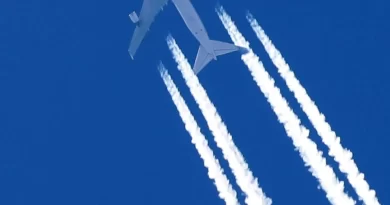Viral video shows blackbirds falling from sky in Mexico

The eerie and bizarre scene, captured by a surveillance camera on Feb. 7, has since gone viral. The mysterious event has sparked an online debate — with several wondering what could have possibly caused the birds to so abruptly plummet to their deaths.
Theories range from the interference of 5G technology to a collision with an invisible spaceship. A local zootechnician suggested the birds had died after inhaling toxic gas from the region’s high levels of pollution — driven by the “use of wood-burning heaters, agrochemicals, and cold weather in the area,” according to local outlet El Heraldo de Chihuahua, which first reported the story. Another one said they could have gotten electrocuted after smacking into a power line.
The striking scene of lifeless birds strewn across a sidewalk has given fodder to social media sleuths trying to piece together the mystery. But what is strange and ripe for speculation actually makes more sense by understanding biology, birds and their survival, said experts, who explained why other hypotheses do not hold up.
For all the theories out there, Kevin J. McGowan, an ornithologist at the Cornell Lab of Ornithology, said that “the only thing that makes sense” was that the birds were fleeing from a predator — and some mistakes were made in their vamoose.
“This truly was an oops moment for the birds,” he said. “A really big oops moment.”
The birds that were too late to hit the break in the video are yellow-headed blackbirds, a migratory species first described in 1825 by the nephew of French emperor Napoleon Bonaparte. Their calls sound like a rusty door opening, with raspy oka-wee-wee sounds. Fleeing winter’s wicked weather, the yellow-headed blackbirds jumble into massive flocks, McGowan said, making their way from Canada and the northern United States toward Mexico during the year’s colder months.
Chihuahua is a known location for these birds to winter. According to the Cornell Lab of Ornithology’s eBird program — a database compiling bird sightings from around the world — large flocks of some 3,000 yellow-headed birds have been spotted this year in the Mexican state. In 2010, McGowan said, over 30,000 were reported.
Known for their golden head and black plumage, the species flies with a sort of herd mentality, the ornithologist said. Without a clear leader, McGowan said the robin-sized birds “have the same goal so they agree to move in the same direction” — much like a school of fish or an angry mob.
When they are being attacked by a predator — such as a falcons, hawks and owls, all of which inhabit Chihuahua — the birds inch closer together to create a tightknit pack.
“The big flocks can make these quick twisting motions, move together very quickly and they all are following the one right next to them who makes the most decisive move,” McGowan said. “They’re wingtip to wingtip in this tight bunch that makes it harder for the predators to actually pick out one and keep up with it.”
But their survival move is not always foolproof. They can sometimes misjudge their speed or the distance from the sky to the ground — resulting in an uncommon, but not unheard of, visual of a bucket of birds being dumped from the sky.
Other scientists agreed with McGowan, dismantling other theories from their observation of the birds’ movement. Richard Broughton, an ecologist at the United Kingdom Centre for Ecology and Hydrology, told the Guardian that the flock looked “like a wave at the beginning, as if they are being flushed from above.” Ronald L. Mumme, an ornithologist and biology professor at Allegheny College, said the birds “dove, became disoriented, and many crashed to the ground and injured themselves,” Newsweek reported.
The reason the other theories do not pan out comes down to bird dynamics, McGowan said.
“Birds are light and fluffy, so they have a lot of wind resistance,” he said. “They don’t fall straight down very quickly, like a baseball. And in this case, they went flying down. It was a purposeful motion.”
If they had died in the air from inhaling poisonous gases — or even hit an alien spaceship — the birds would have tumbled down with a different motion and not risen again after crashing into the ground. Electrocution, as others have posited, is also an unlikely candidate. “I mean with that many birds, they would’ve taken out the power line completely,” McGowan said.
There is also no evidence that birds are affected by 5G technology — that is unless they crash against a network tower.
“There are a lot of conspiracy theories out in the world right now,” McGowan said. “This is weird and unusual, but it’s understandable when you put all the pieces of biology and put in a couple of what-ifs. We do find these accidents happening. Every organism out there is going to die and sometimes they die in weird ways. This was one of those weird ways”
Now, for the thousands of yellow-headed blackbirds that survived and will make their way back north, the ornithologist had a piece of advice: “Please be more careful,” he said.
Read more:

